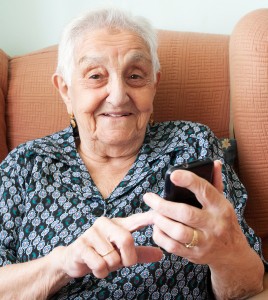Share This
Related Posts
Tags
Tech for Senior Care
By Anca Gagiuc on Aug 26, 2014 in Technology
Statistics show that over 95 percent of the people over 75 years of age prefer to stay at home rather than move to assisted living residences or nursing homes. It’s a perfectly natural desire to remain independent, but for their children this translates into a source of worry – that they may fall, forget to take their meds, or simply just need assistance day to day.
children this translates into a source of worry – that they may fall, forget to take their meds, or simply just need assistance day to day.
In recent years, technology has provided new options to adult children and their parents, revolutionizing the opportunity to stay at home, safely. The new technologies, although still a young industry, not only reduce worries, but enhance family relationships and reduce costs. These technologies vary from very basic to sophisticated.
The technology in development can be broken down into two camps: one for monitoring and surveillance with electronic devices keeping track of a person’s medical condition, and automatically alert health care staff when intervention is required. Sensors are also used throughout the home and will alert the designated person if, for instance, someone has not left the bathroom after a certain period of time, a sign that something may have gone wrong.
Philips Lifeline is a monitoring system with a basic set of features: in case of emergency, users push the button of a pendant they wear on themselves, thus alerting the Lifeline call center. An operator calls on a speakerphone to check on the problem and if no one answers caregivers and emergency medical personnel will be announced. The system has a fall-detection feature that contacts the call center immediately once a fall is detected.
MedMinder is a medication management system that acts like a computerized pillbox. It doses the different medications the user needs to take on a daily basis and when the time comes to take them it beeps and flashes. When the user takes the pills, a phone call is made to the caregiver confirming just that, otherwise, if the pills haven’t been taken within two hours, the system beeps and flashes again and calls the caregiver to notify of the missed dose.
For the cases when those who need monitoring present advanced physical ailments, a basic system is insufficient. GrandCare Systems was created having them in mind. It is a system of customized sensors that sends alerts whenever the defined set of parameters is breached – front door open before 7 AM of after 10 PM, sensors that tell if the person monitored is not out of bed after 10 AM, or if the fridge was open for just a few seconds or a few minutes – a good indicator if the monitored person ate or not. Also, this system can send notifications to the caregiver if the temperature in the home is too high or too low or if the person who needs assistance is restless and wanders from one room to another rapidly.
Similar systems are QuietCare System, BeClose, and E-Neighbor System.
The app market is slowly entering the market – ManDown will send an alert if the Android or Apple smartphone is immobile for a pre-set amount of time that goes up to 24 hours. The app acts like a check-in device, continuously monitoring its movement – if the user doesn’t move, the alarm will automatically activate.
Wristbands are already popular – FitBit Zip, FitBit One, and FitBit Flex measure and monitor heart rates, blood pressure, calorie intake, blood sugar levels, sleep quality, and the number of steps the user takes each day. The data is uploaded to the Fitbit website, syncing automatically to Bluetooth LE, so that the user only needs to share the data with the caretaker, indicator that everything is good.
Smartwatches are also on the rise, promising incorporated health kits. More is to be reveled on the subject during and after this summer with Google and Apple product launches.
It is easy to mistake the monitoring technologies for elderly people with the infamous “nanny cams” used to spy on babysitters. These technologies are developed to help, not to be Big Brother watching you. The decision to use them has to be made by the aging parent and entail open negotiation, because if it’s not the result of an agreement, it can be a very destructive idea.
Have you successfully used any technology to aid in elder care?
